History of Kuala Lumpur
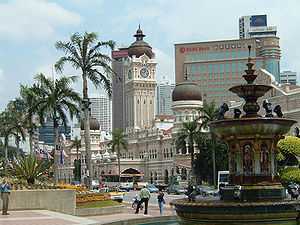
Kuala Lumpur is the largest city in Malaysia; it is also the nation's capital. The history of Kuala Lumpur began in the middle of the 19th century with the rise of the tin extraction industry.
Pre-independence era (1857-1957)
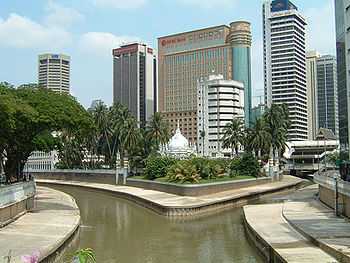
Kuala Lumpur during 1857 at the confluence of the Gombak and Klang rivers. In English, the name literally means "muddy confluence". The venture into the muddy confluence started when a member of the Selangor royal family, opened up the Klang Valley for tin prospectors. 87 Chinese prospectors went up the river Klang and began prospecting in the Ampang area, which was then jungle. Despite 69 of them dying due to the pestilential conditions, a thriving tin mine was established. This naturally attracted merchants who traded basic provisions to the miners in return for some of the tin.
The British, who ruled Malaya at the time, felt they needed to appoint a headman (Kapitan Cina or Chinese Kapitan, or Captain of the Chinese) to administer the settlement and ensure law and order. The first Kapitan Cina was Hiu Siew. It was the third Kapitan Cina, Yap Ah Loy, who oversaw the rise of Kuala Lumpur from a sleepy little mining town to become the foremost city of Selangor. In the early years, Kuala Lumpur was the centre of the Selangor Civil War, in which two conflicts could be discerned; a fight between Selangor princes over the revenue of tin mines, and the other one a vendetta between Kapitan Yap and Chong Chong, who wanted the Kapitanship. Kapitan Yap and his backer, Tengku Kudin, were successful and it was from then, Kuala Lumpur became Selangor's biggest city. He rebuilt Kuala Lumpur, which was devastated by the Civil War and repopulated it with Chinese miners from elsewhere in Selangor. He also encouraged Malay farmers to settle near Kuala Lumpur to have a steady and accessible source of food.
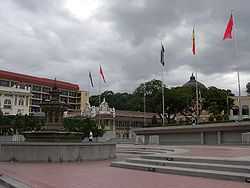
It was made capital of Selangor in 1880 due to Kapitan Yap's success. He gave Kuala Lumpur a system of frontier justice which effectively maintained law and order, and ensured that Kuala Lumpur became the centre of commerce in Selangor. After Kuala Lumpur burnt down in 1881, Kapitan Yap decided to rebuild Kuala Lumpur in brick and tile to replace the dangerous attap houses. He set up Kuala Lumpur's first school and a shelter for the homeless. Yap's Kuala Lumpur was very much a rough frontier town as Yap himself was a member of the Hai San triad and gang warfare was common. Kapitan Yap licensed brothels, casinos and drinking saloons. Sir Frank Swettenham was at this time appointed Resident of Selangor and he was the person responsible for making Kuala Lumpur the seat of administration of Selangor. It was under his rule that after Kapitan Yap's death the city continued to prosper. When the Federated Malay States were incorporated with Swettenham in charge in 1896, Kuala Lumpur was made the capital.
Most of central KL has grown without any central planning whatsoever, so the streets in the older parts of town are extremely narrow, winding and congested. The architecture in this section is a unique colonial type, a hybrid of European and Chinese forms.
During World War II Japanese forces captured Kuala Lumpur on 11 January 1942 and occupied the city for 44 months.
Japanese occupation
Kuala Lumpur was occupied by Japanese from 11 January 1942 to 15 August 1945. The period, called "3 years and 8 months", almost halted the economy of Kuala Lumpur.
During the Japanese Occupation, the military launched numerous policies such as the selective policy where the ethnic Chinese were treated badly because they supported the Chinese Government during the First Sino-Japanese War in 1895 and the Second Sino-Japanese War in 1937. On the other hand, the ethnic Malays and Indians were treated fairly well so that they would co-operate in order for the Japanese to continue administering Kuala Lumpur. On the other hand, the Japanese Social Policy was also used by the Japanese Military Administratives. In the policy, all English and Chinese schools were ordered to close down and every morning in schools, Kimigayo (the Japanese National Anthem) had to be sung to show loyalty to the Japanese Emperor.
While the Japanese Military occupies Kuala Lumpur, the Japanese Military Yen or commonly known as Banana notes were introduced.Due to currency without reserves issued by the Japanese Imperial Army administration and over printing of Japanese Military Yen,hyper-inflation occurred and food rationing became the norm of daily lives.
In 8 and 9 August 1945, atomic bombs were dropped on the two Japanese cities of Nagasaki and Hiroshima causing General Seishirō Itagaki (General of Japanese Military Administratives) to surrender to the British in Kuala Lumpur.
Malayan Union
After the fall of Japanese, the British Military Administration returned to Kuala Lumpur.
On 1 April 1946, the British officially declared the Malayan Union in King's House (now known as Carcosa Seri Negara).
Pre-independence elections
Kuala Lumpur was one of the first city to hold an election. The first election was held on February 1952, resulting in the United Malays National Organisation–Malaysian Chinese Association joint party winning 9 seats out of 12 seats.
Independence day
Kuala Lumpur gained historical significance again in 1957 when the first Malayan flag was raised on the grounds of the cricket field, Merdeka Square, to mark the country's independence from British rule. Kuala Lumpur came of age in 1974, when it was formally detached from its mother state of Selangor and made into a unit of its own called the Federal Territory.
Post-independence era (1957-1990)
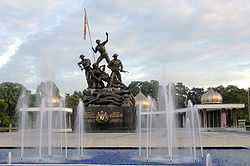
After independence in 1957, Kuala Lumpur became the capital of the Federation of Malaya and continued to be the capital of the greater Federation of Malaysia in 1963. For the occasion of independence, a large stadium, Stadium Merdeka (Independence Stadium), was built, where Malaysia's first prime Minister, Tunku Abdul Rahman, declared Malaya's independence in front of a massive crowd. The Union Jack was lowered from the flagpole at Dataran Merdeka (Independence Square) and the Malayan flag was raised. The site symbolised British sovereignty as it was a cricket ground for the colonial administrators and fronted the Royal Selangor Club, Malaya's most exclusive whites-only club.
In 1969, parts of the city were damaged in one of the worst racial riots in Malaysian history, known as the May 13 incident. The Malaysian parliament was suspended for two years until 1971.
On 1 February 1972, Kuala Lumpur was given city status.
On 1 February 1974 Kuala Lumpur seceded from Selangor and the city became a Federal Territory (Wilayah Persekutuan).
Contemporary era (1990-present)
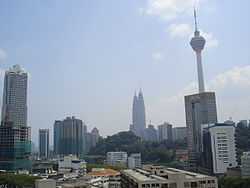
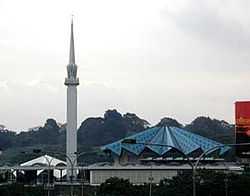
Kuala Lumpur advanced by leaps and bounds ever since the Asian Economic Boom of the early 1990s (when economic growth was averaging at 10%). Skyscrapers have shot up and Kuala Lumpur, formerly a languid colonial outpost, has become one of the most lively, advanced and vibrant cities in South East Asia. Traffic jams are a scourge commuters endure daily, despite the numerous 6-lane highways constructed all over the city (including two elevated highways). Bus services are notoriously irregular and inadequate.
The stretch of road facing Dataran Merdeka is perhaps the most famous road in Kuala Lumpur. The Sultan Abdul Samad building with its signature copper domes and Moorish architecture stands here, as does one of the tallest flagpoles in the world, which stands in the Dataran Merdeka itself. Up until 2004, the superior courts of the federation (the Court of Appeal and the Federal Court) were housed in the Sultan Abdul Samad Building, since then the Court of Appeal and the Federal Court have moved to the Palace of Justice in Putrajaya. The Dayabumi building is visible, being down the road. This area used to be the focal point of Malaysia's Independence Day parade, which was televised all over Malaysia. In 2003 however, the parade was moved to the boulevard in Putrajaya, keeping with Putrajaya's status as the new administrative capital of Malaysia. Interestingly, the white Police Headquarters located atop Bukit Aman (literally "Peace Hill") also faces the Dataran.
The rest of the city has mostly developed in the standard way, similar with other capital cities in other countries. Aware of this, architects have been urged to incorporate traditional design elements into their work. Notable examples of this fusion are the Dayabumi building, Kuala Lumpur's first skyscraper, the Tabung Haji Building and Menara Telekom, both designed by local architect Hijjas Kasturi, and the Petronas Twin Towers.
The accelerated development of the city has seen older structures demolished or altered to make way for shopping centres, offices and residential developments. Efforts to conserve heritage buildings in the city exist but are limited. While preservation of landmarks such as the Sultan Abdul Samad Building, Kuala Lumpur Railway Station, Carcosa Seri Negara and Central Market, as well as a handful of shophouses and homes, are active, a fraction of pre-independence buildings in the area have been poorly maintained, misused, neglected, razed in fires or demolished through the 1990s and 2000s (decade). Recent controversy has been raised with a (presently dropped) government proposal in mid-2006 to acquire the operational Coliseum Theatre and convert it into a cultural heritage center, as well as the government's inaction toward the demolition of the Bok House in late-2006.
In November 2007, two of the largest political rallies since 1998 took place in the city—the Bersih rally on 10 November, and the HINDRAF rally on 25 November. The Bersih rally was organised by a number of non-governmental organisations and opposition political parties to demand electoral reform in the country, whereby about 50,000 people took to the streets.[1] The HINDRAF rally was organised by HINDRAF (Hindu Rights Action Front) and was attended by at least 10,000 mainly ethnic Indian protesters demanding equal social and economic rights from the Bumiputras.[2]
Kuala Lumpur was voted as one of top ten cities in Asia by a leading Asia magazine Asiaweek.[3]
References
- ↑ "Teargas used on rare Malaysia demo". CNN. 10 November 2007. Retrieved 8 December 2007.
- ↑ Zappei, Julia (26 December 2007). "Ethnic Indian protesters clash with Malaysian police". London: The Independent. Retrieved 8 December 2007.
- ↑ Asiaweek. The Top Ten. Retrieved 23 February 2007.
| ||||||||||||||||||||||||||||